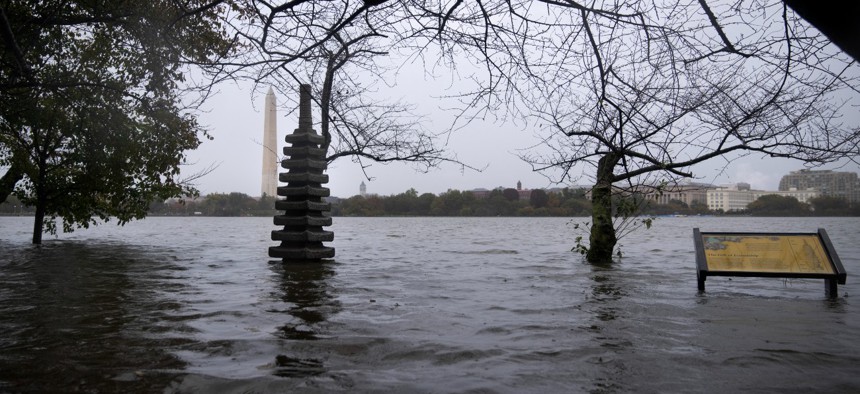
The Japanese Pagoda statue is partially submerged as water rises along the Tidal Basin after heavy rains caused flooding in the Mid-Atlantic region on Oct. 29, 2021 in Washington, D.C. The Biden administration has called for better data and modeling to be able to measure the true cost of climate change to federal property. Drew Angerer/Getty Images
Failing to Invest in Climate Change Means Failure to Taxpayers, Says New Assessment
A climate assessment included in the president's budget request adheres to an executive order issued in May 2021.
While the numbers in a new climate evaluation are preliminary, the message is clear: damage could be coming to federal property and the country needs to act now.
A section of the president’s budget request for fiscal 2024 released this past week looks at the increased costs and risks to the federal government as a result of climate change. It carries out the requirements of an executive order President Biden issued in May 2021 on climate-related financial risks.
“Climate risk data shows us that if we fail to invest in climate change, we are failing at our responsibility to properly manage funding on behalf of taxpayers,” said the budget documents. “Near-term federal investments to both mitigate [greenhouse gas] emissions and adapt to future climate scenarios can help reduce future financial burdens, but will rely on both congressional appropriations and federal implementation to reduce those risks.”
For sea level rise, “researchers found that there is currently no public or private sector climate data available to accurately estimate the cost implications of sea level rise on federal facilities,” said the assessment. However, in an illustrative analysis using public data, which had various limitations and thus is likely an underestimate, “the annual replacement value affected from sea level rise is projected between $72 million and $127 million for mid-century and between $449 million and $1.786 billion by the end of the century.” The Biden administration said this underscores the need to have better data and modeling to be able to measure the true cost of climate change.
Another assessment was flood risks to civilian federal facilities.
“Assuming that federal buildings and structures remain in their current sites and not accounting for newly built facilities over the next 30 years, the percent of buildings in the expanded floodplain in the 2052 100-year floodplain is projected 3% greater than the 2032 100-year floodplain,” said a white paper accompanying the assessment. A 100-year floodplain which are areas that have at least a 1% chance of flooding annually. The estimated percentage increase for buildings in the 500 plain, meaning areas that have at least a 0.2% chance of flooding annually, is the same.
The estimated annual replacement value for a 100-year flood event is estimated to increase between $10 million and $39 million by 2052. For a 500-year flood event, it is projected to increase between $2 million and $5 million.
“While this year’s assessment on the flood risks to federal facilities has made notable improvements relative to last year’s assessment, there are still significant caveats to the analysis,” said the budget documents. “The extent of future changes in flood risk has not been estimated across the full federal inventory of real property.” Also, the white paper notes that the results this year are substantially different from those of last year because of an updated methodology.
The fiscal 2024 budget proposal would invest $52.2 billion in discretionary funding to curb the climate crisis. This includes: $15 billion for clean energy advancement and emissions mitigation and $24 billion for climate resilience and adaptation actions across the federal government.
Candace Vahlsing, associate director for climate, energy, environment, and science at the Office of Management and Budget and Zach Liscow, chief economist at OMB, highlighted in a blog post on Tuesday actions the Biden administration has already taken in the past two years to tackle the climate crisis, such as enactment of the Inflation Reduction Act, which was a $369 billion investment in modernizing the country’s energy system and the Environmental Protection Agency’s proposal of a rule to target methane emissions in oil and gas operations.
“[The Council of Economic Advisers] and OMB are jointly collaborating with interagency partners to improve existing methods to quantify the macroeconomic effects of climate change and building the clean energy economy of the future,” wrote Vahlsing and Liscow. “Accounting for climate risk in both the economic forecasting and the program analysis that underpins the president’s budget will help limit the costs of climate change to our economy and our health – and help ensure a brighter future.”







